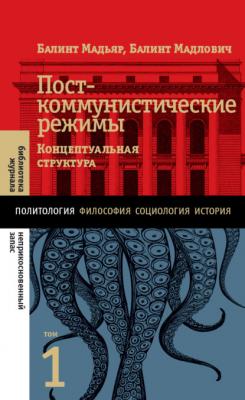Посткоммунистические режимы. Концептуальная структура. Том 1. Балинт Мадьяр
Чтение книги онлайн.
Читать онлайн книгу Посткоммунистические режимы. Концептуальная структура. Том 1 - Балинт Мадьяр страница 27
 A. Democracy as a Universal Value // Journal of Democracy. 1999. Vol. 10. № 3. P. 3–17.
A. Democracy as a Universal Value // Journal of Democracy. 1999. Vol. 10. № 3. P. 3–17.
17
Schmitter P., Karl T. The Conceptual Travels of Transitologists and Consolidologists // Slavic Review. 1994. Vol. 53. № 1. P. 173–185; Bunce V. Should Transitologists Be Grounded? // Slavic Review. 1995. Vol. 54. № 1. P. 111–127; Levitsky S., Way L. Competitive Authoritarianism: Hybrid Regimes after the Cold War. Cambridge: Cambridge University Press, 2010.
18
Carothers T. The End of the Transition Paradigm // Journal of Democracy. 2002. Vol. 13. № 1. P. 5–21; Levitsky S., Way L. Competitive Authoritarianism: Hybrid Regimes after the Cold War.
19
См. например, критический метаанализ этих изменений: Cassani A. Hybrid What? Partial Consensus and Persistent Divergences in the Analysis of Hybrid Regimes // International Political Science Review. 2014. Vol. 35. № 5. P. 542–558.
20
См. например, критический метаанализ: Bogaards M. Where to Draw the Line? From Degree to Dichotomy in Measures of Democracy // Democratization. 2012. Vol. 19. № 4. P. 690–712.
21
Bunce V. Should Transitologists Be Grounded? P. 112. Ср.: Sartori G. Comparing and Miscomparing // Journal of Theoretical Politics. 1991. Vol. 3. № 3. P. 243–257.
22
Хантингтон С. Третья волна. Демократизация в конце XX века. М.: РОССПЭН, 2003.
23
Zakaria F. The Rise of Illiberal Democracy // Foreign Affairs. 1997. Vol. 76. № 6. P. 22–43.
24
Хантингтон С. Третья волна; O’Donnell G., Schmitter P. Transitions from Authoritarian Rule: Comparative Perspectives. Baltimore and London: Johns Hopkins University Press, 1986; Schmitter P. Transitology: The Science or the Art of Democratization? // The Consolidation of Democracy in Latin America. Boulder: Lynne Rienner, 1995. P. 11–41; Przeworski A. Transitions to Democracy // Democracy and the Market. Cambridge: Cambridge University Press, 1991. P. 51–99.
25
Linz J., Stepan A. Problems of Democratic Transition and Consolidation: Southern Europe, South America, and Post-Communist Europe. Baltimore; London: Johns Hopkins University Press, 1996; Mainwaring S., O’ Donnell G., Valenzuela J. S. Issues in Democratic Consolidation: New South American Democracies in Comparative Perspective. Notre Dame: University of Notre Dame Press, 1992; Diamond L. Developing Democracy: Toward Consolidation. Baltimore: Johns Hopkins University Press, 1999.
26
Schimmelfennig F., Sedelmeie U. The Europeanization of Central and Eastern Europe. New York: Cornell University Press, 2005.
27
Levitz P., Pop-Eleches G. Why No Backsliding? // Comparative Political Studies. 2010. Vol. 43. № 4. P. 457–485.
28
Magyar B. Parallel System Narratives: Polish and Hungarian Regime Formations Compared // Stubborn Structures: Reconceptualizing Post-Communist Regimes. Budapest; New York: CEU Press, 2019. P. 611–655.
29
Collier D., Levitsky S. Democracy with Adjectives: Conceptual Innovation in Comparative Research // World Politics. 1997. Vol. 49. № 3. P. 430–451.
30
Пример метаанализа см.: Bogaards M. How to Classify Hybrid Regimes? Defective Democracy and Electoral Authoritarianism // Democratization. 2009. Vol. 16. № 2. P. 399–423.
31
Diamond L. Thinking About Hybrid Regimes.
32
Croissant A. From Transition to Defective Democracy: Mapping Asian Democratization // Democratization. 2004. Vol. 11. № 5. P. 156–178.
33
Bozóki A. Beyond «Illiberal Democracy»: The Case of Hungary // New Politics of Decisionism. Hague: Eleven International Publishing, 2019. P. 94–98.
34
Bozóki A., Hegedűs D. Democracy, Dictatorship and Hybrid Regimes.
35
Wigell M. Mapping «Hybrid Regimes»: Regime Types and Concepts in Comparative Politics // Democratization. 2008. Vol. 15. № 2. P. 230–250.
36
Gilbert L., Mohseni P. Beyond Authoritarianism: The Conceptualization of Hybrid Regimes // Studies in Comparative International Development. 2011. Vol. 46. № 3. P. 270.
37
Kornai J. The System Paradigm Revisited: Clarification and Additions in the Light Of Experiences in the Post-Communist Region // Stubborn Structures: Reconceptualizing Post-Communist Regimes. P. 21–74.
38
Ср.: Armony A., Schamis H. Babel in Democratization Studies // Journal of Democracy. 2005. Vol. 16. № 4. P. 113–128.
39
Dobson W. The Dictator’ s Learning Curve: Inside the Global Battle for Democracy. New York: Anchor, 2013.
40
Слово «общинный», выбранное для перевода третьего из типов социального действия, который в оригинале обозначается как communal, следует понимать в широком смысле – как относящийся к тесно связанному сообществу людей, разделяющих некий набор ценностей,